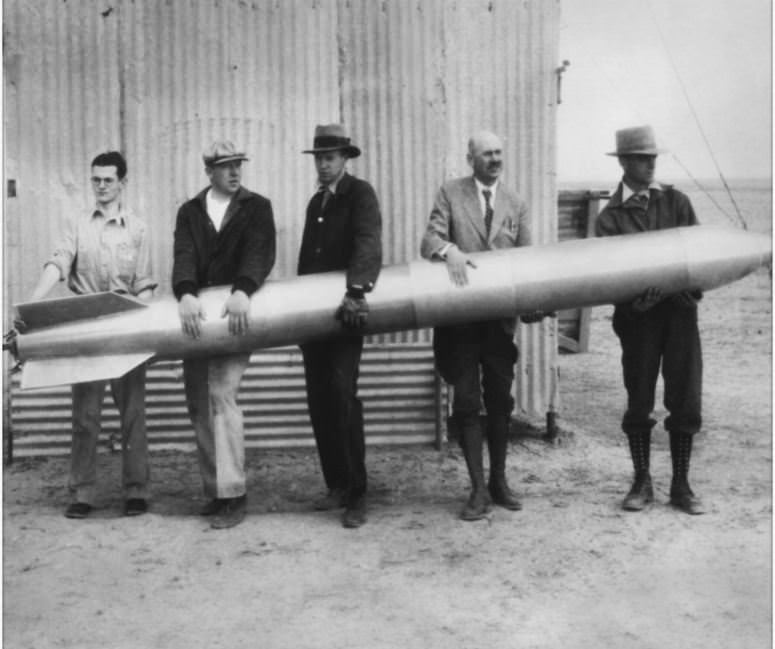It is difficult to say what is impossible, for the dream of yesterday is the hope of today and the reality of tomorrow. -- Dr. Robert Hutchings Goddard
It's funny sometimes, the things that inspire you. I remember in second grade, our class read a story about Robert Goddard and I was totally captivated by this man who had a practically single-minded vision to build rockets and visit other worlds. That story was my first exposure – that I recall – to rockets and space travel and other planets, and I have to say, Robert Goddard is one of the reasons I'm a space and astronomy journalist today. I remembered that 2nd grade fascination and inspiration when I saw the above picture of Goddard and his co-horts with one of their rockets. Today is Robert Goddard's birthday – he was born on October 5, 1882 -- and in my recollections, I also remembered what inspired Robert Goddard: daydreaming while sitting in the branches of a tree.
The story goes that on October 19, 1899, he climbed into an old cherry tree to prune its dead branches. Instead, he began daydreaming.
Goddard later wrote about that day:
"It was one of the quiet, colorful afternoons of sheer beauty which we have in October in New England, and as I looked toward the fields at the east, I imagined how wonderful it would be to make some device which had even the possibility of ascending to Mars, and how it would look on a small scale, if sent up from the meadow at my feet."
"I was a different boy when I descended the tree from when I ascended, for existence at last seemed very purposive."
That was when a 17-year old Goddard decided to pursue the idea of spaceflight. October 19 became Goddard's day of inspiration and he remembered that day every year, calling it "Anniversary Day," and he noted the day in his diary as his personal holiday. In 1913, for example, he made the following to-do list:
Worcester, October 19, 1913 (Anniversary Day)
Order: complete patent application if necessary of nozzle and plurality; take out application on reloading feature; also complete application for electric pump; repeat calculation carefully, for smaller intervals; look up Darwin's theory of the lunar motion; and look up meteors. Also try a jet.
Until that time, any type of rocket propulsion was provided by various types of gunpowder. Goddard wanted to try using a liquid fueled rocket. But in some of Goddard's first tests of the rocket, and specifically in testing the type of jet nozzles he used, he was extremely disappointed in the nozzle's performance: only about 2% of the available energy contributed to the speed of the jet.
Then Goddard found inspiration from an engineer named Gustav De Laval, who had developed a more efficient steam engine by designing a nozzle that was narrow at the point of entry and then expanded. This increased the speed of the jet and led to a very efficient conversion of heat energy to motion.
Using a De Laval nozzle, Goddard was able to obtain jet velocities between 7000 and 8000 ft/sec and efficiencies of up to 63%. The De Laval nozzle made Goddard's dream of spaceflight a reality.
By 1914, Goddard had received a U.S. patent for a rocket using liquid fuel and another for a two- or three-stage rocket using solid fuel. By 1926, he and his team had constructed and successfully tested a rocket using liquid fuel, and the first-of-its-kind rocket reached an altitude of 12.5 meters (41 feet) with the flight lasting about 2 seconds. That small success was enough to inspire Goddard to go on to build more rockets. His research and achievements in rocket propulsion have formed the fundamental principles of space flight.
And Goddard wasn't the only one who was inspired by De Laval. In the book "Rocket Boys," which was later made into the movie "October Sky," former NASA engineer Homer Hickam tells about his inspiration of building a rocket after seeing Sputnik fly over his backyard. He gets a group of his high school friends to help him, and they work relentlessly on building homemade rockets. The boys' breakthrough of building a science-fair-winning rocket comes when they discover the design of the De-Laval nozzle in a book given to them by their teacher.
It's true: we do all stand on the shoulders of giants.
 Universe Today
Universe Today
